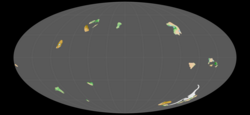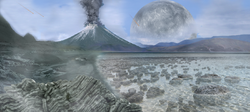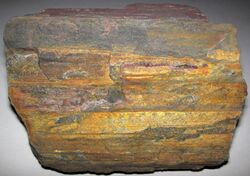Earth:Mesoarchean
| Mesoarchean | |
|---|---|
| 3200 – 2800 Ma | |
 A reconstruction of the Earth's continents during the middle Mesoarchean, c. 3 Ga. | |
 Artist impression of the Archean eon | |
 Banded iron formation created during the Mesoarchean era | |
| Chronology | |
| Proposed redefinition(s) | 3490–2780 Ma Gradstein et al., 2012 |
| Proposed subdivisions | Vaalbaran Period, 3490–3020 Ma Gradstein et al., 2012 |
| Etymology | |
| Name formality | Formal |
| Alternate spelling(s) | Mesoarchaean |
| Usage information | |
| Celestial body | Earth |
| Regional usage | Global (ICS) |
| Time scale(s) used | ICS Time Scale |
| Definition | |
| Chronological unit | Era |
| Stratigraphic unit | Erathem |
| Time span formality | Formal |
| Lower boundary definition | Defined Chronometrically |
| Upper boundary definition | Defined Chronometrically |
The Mesoarchean (/ˌmiːzoʊ.ɑːrˈkiːən, ˌmɛzoʊ-/ MEE-zoh-ar-KEE-ən, MEZ-oh-, also spelled Mesoarchaean) is a geologic era in the Archean Eon, spanning 3,200 to 2,800 million years ago, which contains the first evidence of modern-style plate subduction and expansion of microbial life. The era is defined chronometrically and is not referenced to a specific level in a rock section on Earth.
Tectonics


The Mesoarchean era is thought to be the birthplace of modern-style plate subduction, based on geologic evidence from the Pilbara Craton in western Australia .[1][2] A convergent margin with a modern-style oceanic arc existed at the boundary between West and East Pilbara approximately 3.12 Ga. By 2.97 Ga, the West Pilbara Terrane converged with and accreted onto the East Pilbara Terrane.[2] A supercontinent, Vaalbara, may have existed in the Mesoarchean.[3]
Environmental conditions
Analysis of oxygen isotopes in Mesoarchean cherts has been helpful in reconstructing Mesoarchean surface temperatures.[4] These cherts led researchers to draw an estimate of an oceanic temperature around 55-85°C[5] while other studies of weathering rates postulate average temperatures below 50°C.
The Mesoarchean atmosphere contained high levels of atmospheric methane and carbon dioxide, which could be an explanation for the high temperatures during this era.[4] Atmospheric dinitrogen content in the Mesoarchean is thought to have been similar to today, suggesting that nitrogen did not play an integral role in the thermal budget of ancient Earth.[6]
The Pongola glaciation occurred around 2.9 Ga, from which there is evidence of ice extending to a palaeolatitude (latitude based on the magnetic field recorded in the rock) of 48 degrees. This glaciation was likely not triggered by the evolution of photosynthetic cyanobacteria, which likely occurred in the interval between the Huronian glaciations and the Makganyene glaciation.[7]
Early microbial life
Microbial life with diverse metabolisms expanded during the Mesoarchean era and produced gases that influenced early Earth's atmospheric composition. Cyanobacteria produced oxygen gas, but oxygen did not begin to accumulate in the atmosphere until later in the Archean.[8] Small oases of relatively oxygenated water did exist in some nearshore shallow marine environments by this era, however.[9]
See also
- Earth:Geologic time scale – System that relates geologic strata to time
- Earth:Glacial period – Interval of time within an ice age that is marked by colder temperatures and glacier advances
- Earth:Ice age – Period of long-term reduction in temperature of Earth's surface and atmosphere
- Earth:Last glacial period
References
- ↑ Mints, M.V.; Belousova, E.A.; Konilov, A.N.; Natapov, L.M.; Shchipansky, A.A.; Griffin, W.L.; O'Reilly, S.Y.; Dokukina, K.A. et al. (2010). "Mesoarchean subduction processes: 2.87 Ga eclogites from the Kola Peninsula, Russia". Geology 38 (8): 739–742. doi:10.1130/G31219.1. ISSN 0091-7613. Bibcode: 2010Geo....38..739M. https://doi.org/10.1130/G31219.1.
- ↑ 2.0 2.1 Smithies, R. H.; Van Kranendonk, M. J.; Champion, D. C. (2007). "The Mesoarchean emergence of modern-style subduction". Gondwana Research. Island Arcs: Past and Present 11 (1): 50–68. doi:10.1016/j.gr.2006.02.001. ISSN 1342-937X. Bibcode: 2007GondR..11...50S. https://www.sciencedirect.com/science/article/pii/S1342937X06000669.
- ↑ de Kock, Michiel O.; Evans, David A. D.; Beukes, Nicolas J. (2009). "Validating the existence of Vaalbara in the Neoarchean". Precambrian Research 174 (1): 145–154. doi:10.1016/j.precamres.2009.07.002. ISSN 0301-9268. Bibcode: 2009PreR..174..145D. https://www.sciencedirect.com/science/article/pii/S0301926809001429.
- ↑ 4.0 4.1 Sleep, Norman H.; Hessler, Angela M. (2006). "Weathering of quartz as an Archean climatic indicator". Earth and Planetary Science Letters 241 (3–4): 594–602. doi:10.1016/j.epsl.2005.11.020. Bibcode: 2006E&PSL.241..594S. https://doi.org/10.1016/j.epsl.2005.11.020.
- ↑ Knauth, L. Paul; Lowe, Donald R. (2003). "High Archean climatic temperature inferred from oxygen isotope geochemistry of cherts in the 3.5 Ga Swaziland Supergroup, South Africa". Geological Society of America Bulletin 115: 566–580. doi:10.1130/0016-7606(2003)115<0566:HACTIF>2.0.CO;2. ISSN 0016-7606. Bibcode: 2003GSAB..115..566K. https://pubs.geoscienceworld.org/gsa/gsabulletin/article-abstract/115/5/566/183983/High-Archean-climatic-temperature-inferred-from?redirectedFrom=fulltext.
- ↑ Marty, Bernard; Zimmermann, Laurent; Pujol, Magali; Burgess, Ray; Philippot, Pascal (2013). "Nitrogen isotopic composition and density of the Archean atmosphere". Science 342 (6154): 101–104. doi:10.1126/science.1240971. PMID 24051244. Bibcode: 2013Sci...342..101M. https://www.science.org/doi/10.1126/science.1240971.
- ↑ Kopp, Robert E.; Kirschvink, Joseph L.; Hilburn, Isaac A.; Nash, Cody Z. (2005). "The Paleoproterozoic snowball Earth: A climate disaster triggered by the evolution of oxygenic photosynthesis". Proc. Natl. Acad. Sci. U.S.A. 102 (32): 11131–6. doi:10.1073/pnas.0504878102. PMID 16061801. Bibcode: 2005PNAS..10211131K.
- ↑ Lepot, Kevin (2020). "Signatures of early microbial life from the Archean (4 to 2.5 Ga) eon". Earth-Science Reviews 209: 103296. doi:10.1016/j.earscirev.2020.103296. ISSN 0012-8252. Bibcode: 2020ESRv..20903296L.
- ↑ Eickmann, Benjamin; Hofmann, Axel; Wille, Martin; Bui, Thi Hao; Wing, Boswell A.; Schoenberg, Ronny (15 January 2018). "Isotopic evidence for oxygenated Mesoarchaean shallow oceans". Nature Geoscience 11 (2): 133–138. doi:10.1038/s41561-017-0036-x. https://www.nature.com/articles/s41561-017-0036-x?error=cookies_not_supported&code=54e99c94-9890-439d-a813-c26d056ce863. Retrieved 28 December 2022.
External links
 |


